One of the oldest cities in the world, perched atop the proud Messa Vouno Mountain on the island of Santorini… Thera was a rich populous zone from the 9th century to 726 AD. Thera saw the rise and fall of fierce Spartan colonists and then the Byzantines and the Romans. Incidentally, these spectacular ruins in Mesa Vouna (Santorini’s second-highest mountain is around 400 meters high) are flanked by two of Santorini’s most popular beaches; Kamari and Perissa.
Though most of the ruins date back to the Hellenistic era, some archaeological findings also belong to the Byzantine and Roman periods. The combination of these eye-catching ruins on a rocky bed with exceptional views of the volcanic cliffs and the Aegean sea make up an interesting cocktail… one that’s hard to resist.
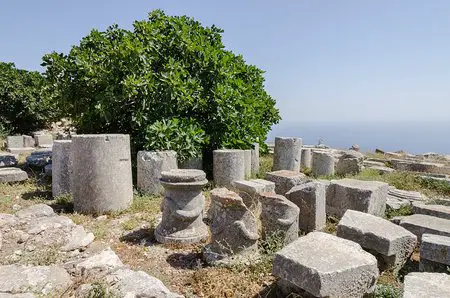
Background
One of the important chapters of Santorini’s history is connected to the story of Ancient Thera. The excavations here began quite early (1896) and they were done by Baron Hiller von Gaertringen in Mesa Vouno. The residential area and some parts of Thera cemeteries were all excavated by 1902. The results showed that a settlement had existed here in the 9th century BC.
Thera’s geographical advantages were many… it lay in a fortified spot flanked by Profitis Ilias and Mesa Vuono that were joined by the Sellada ridge. Fierce Dorian/Spartan colonists led by their leader named Theras founded a city here and that’s how this city got its name. They built roads to Kamari (port) and Perissa (trade hub) and propelled Thera to a state of reasonable prosperity. To understand the fascinating practices and lives of Spartans you could watch the popular Hollywood movie 300. The Spartans were evicted later and around the 4th century, Thera became a prominent Egyptian Naval base and a huge garrison was established there.
The archaeologists have established that a Hellenistic settlement (800 meters long and 150 meters wide) existed in Thera from the north-west to the south-west. The settlement was bisected in the middle by a central street and side streets went off from it like branches from a tree.
Many ancient art forms were excavated from Thera and they included pottery from the Geometric period that survived in good condition. Theran ceramics in a variety of styles were discovered and they suggest cross-cultural influence. Thera was at the crossroad of trade routes from Rhodes, Attica, Ionia and Corinth and this was why it was a sort of cosmopolitan ambience.
Things To See & Do
While going up to Thera do not miss the small white church that stands around midway of the trail… it is clearly visible from the bottom of the road. Mass is held at this church on 25th March every year. Incidentally, this church is called St Stephen of Santorini and Mesa Vuono was also earlier called Mountain of St Stephen. Mesa Vuono’s Sellada (the area containing the cemeteries) is also referred to as the ‘neck’ that connects the mountain with the mountain of Prophet Elias.
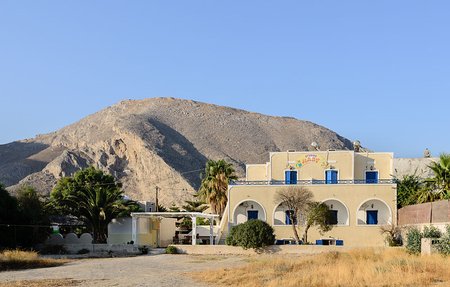
Around this same point, there is a cave and a spring spurting out drinking water… this was where the residents of the settlement used to collect their drinking water.
Some of the most important buildings dug up in the excavations are:
Two Agoras/ main city squares stand at the juxtaposition of the main street that imitates the curves of the mountain ridge (it is estimated to be 110 m long and 30 m wide). Archaeologists have found Greek temple ruins apart from vestiges of Roman Baths, Byzantine period walls and Hellenistic era shops. Everything is pretty much mixed together in the ruins due to the Greek practice of building on fallen buildings without disposing of the underlying debris.
The Agoras are circled by a string of sanctuaries. The spur of the mountain ridge has a sacred area that has a grotto dedicated to Heracles and Hermes. The Apollo Karneios temple used to be nearby that’s a part of the joint rock sanctuary dating back to the 6th century. The sanctuary includes a temple embellished with cella and Pronaos apart from a square courtyard with 6 monolithic pillars and an underground cistern.
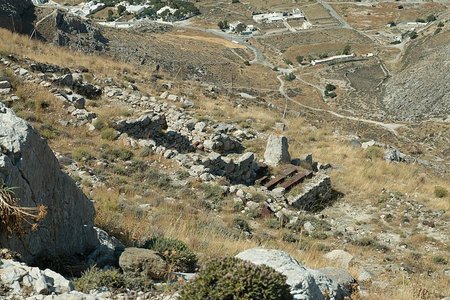
There are many open-air sanctuaries in this zone (south-east edge of the city) and they include the sanctuary of Ptolemy too. The sanctuaries date back to different periods and have inscriptions ranging from archaic to Roman periods.
All public buildings were organised towards the west side of the slope while the east side towards the ocean has a free view. All private buildings on ancient Thera were purposefully built to be at a lesser height than Agora. A largish Portico (46 x 10 m total area) extends along the agora and serves as the epicentre of public life. The roof is supported by a long row of ten Doric pillars that go along the middle axis.
Ancient Thera had a theatre that was supposedly constructed in the 2nd century on the slope lying below the main street. This was one of the biggest theatres on the Greek islands and its seating capacity (1500) exceeded the city’s demand. This theatre became the epicentre of the islands entertainment activities and performers from far off came here to perform while people from distant settlements travelled to the Thera theatre to watch.
The Temple of Dionysos was erected for the ancient Gods of Egypt in the 3rd century. The ruins of the marble façade of the Dionysos Temple can still be found here.
There was a huge Terrace of Festivals in Thera where young boys engaged in a naked dance (Gymnopaediae)… a custom to honour Apollo. You can still see phallic themed graffiti in Thera and this is estimated to be as old as Roman times.
Another good site to visit is the cemeteries of ancient Thera that lie on the slopes of the Sellada on both sides of the road that goes up to Perissa and Kamari. These graves span across all periods from the Geometric era to the Roman.
Thera presents an interesting historical perspective on the social hierarchy. For example, at the city’s highest point right at the end of the cul de sac, there is a statuesque building indicating the rank of its inhabitant… the fleet commander. There is a huge courtyard that extends on both sides and that’s probably the garrison’s gymnasium. This is different from the Gymnasium of the youths that lies on the southern edge of the city… this one dates back to the 2nd century.
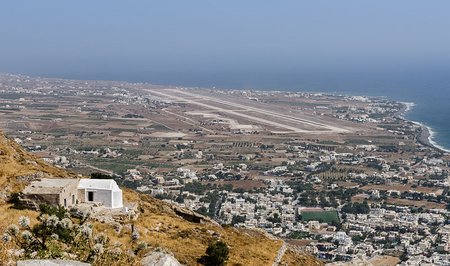
The southwest part of Thera also holds the remains of Royal Stoa that was built in the times of Emperor Augustus. The entrance of the Stoa faces the Agoda and Doric colonnades support the roof. Remains of the statues of Caesar’s family are seen in the northern part of the Stoa. There are two inscribed slabs built in the west wall that show the year in which the portico was repaired ‘AD 149’.
Amongst the ruins of private houses, a trained guide might be able to point out important differences. The fleet officers stayed in peristyle houses graced with colonnades on the east slope terraces… all of these had excellent ocean views. The city’s ordinary citizens lived on the plateau and their houses all huddled around a central courtyard. There was once a cistern underneath to provide a source of water.
Many important finds sourced from here have been moved to the museums of Fira but what remains is also excellent value.
As mentioned, ancient Thera is flanked by the Perissa and Kamari beaches, so from two different sites on Thera you will get gorgeous views of the beaches. On the Kamari side, you can also see the airport while on the Perissa side you can check out the Perivolos beach. The Perissa village with its long black beach, hotels, houses and white churches with blue domes look especially attractive. Look inland and there is a nice view of the Prophet Elias Mountain that contains a scenic monastery museum.
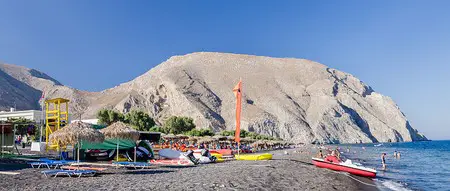
There are lots of well-articulated plaques that detail the history of this ancient city and its many visit-worthy sites. There are no massive crowds here like in Acropolis or other archaeological sites of Greece. The position of ancient Thera makes it seem like it’s cut off from the rest of the world… an aspect that adds to its charm. It’s incredible to think that a whole town existed here with a theatre, market churches and gym.
If you are an avid hiker then try walking from Kamari to Perissa or Perissa to Kamari… it’s a popular trekking route and the Mesa Vouno with ancient Thera always falls in the middle. The paved road leading up to Thera is from Kamari, the Kamari beach is visible clearly from it and you will probably end up spending a lot of time in photography at the road itself.
There is a small shop selling coffee, water and snacks at the top but there is no washroom which may be a major issue for some.
Open Hours
- Open from 8.30 a.m. to 3.30 p.m. on every day of the week in winters (6th November to 31st March) except Tuesdays
- Open from 8.30 a.m. to 4.00 p.m. on every day of the week in summers (15th April to 31st October) except Tuesdays
- The visiting hours aren’t many, so obviously you should aim to start off as early as you can so that you can get a guaranteed parking slot and explore the area fully.
Tickets & Tours
There is a 4 euro entry fee for adults while seniors and retired/ pensioners can get the discounted 2 euro entry ticket.
For a 14 euro fee, you can get a 4-day package ticket that includes entry to many other sites apart from Ancient Thera like Akrotiri, Archaeological Museum, Museum of Prehistoric Thera, Collection of Icons and Ecclesiastical Artefacts at Pyrgos. The package ticket is a great offer as the Akrotiri entrance ticket alone costs 12 euros.
Thera was once a bustling populous city but now all that is left are all ruins. These ruins (even with the aid of information plaques) are difficult to manoeuvre and understand, so a guided tour will help in understanding the structural differences of the buildings, the layout of the city and important landmarks.
You will see many local guides wandering around the entry kiosk so you could book one of them. Otherwise, you can book a comprehensive 4 hour guided tour of Santorini from Viator that lets you see chosen sights including ancient Thera with the constant presence of an English speaking guide who explains the history and features of the attractions. Book the guided Santorini tour from this Viator site.
How To Reach
You need to climb to a mountain top to reach Thera and it will take you approximately more than an hour to reach the top. The rewards are high as you will get amazing views from each step apart from the spectacular 360-degree view at the top. However, if you are not fit then you will end up spending all your energy before you actually reach the Ancient Thera site and there is a lot of walking around to do there too.
In case you are determined to walk, bring along snacks and water and rest awhile on the benches that are positioned after halfway of the trail. Drive up instead to the tiny roundabout and park if you want to save up on energy. If you are scared of heights and steep drop-offs, avoid looking out of the window. Remember that the road is narrow and fit for ATV’s and small cars and not for big MPVs and SUVs. The paved road on which cars and tour minibuses can run is only from the Kamari side and from the Perissa side, there is only a roughhewn path with stones that walkers can use.
There is a small parking area here (Parking is free) and as you go further, a tiny church will greet you. The wind is very severe here and you need to keep your camera/ phone securely. The entry gate is a little past the tiny church and you need to pay the entry fee here before going up to the site.
Address: Ancient Thera Road, Kamari 17892, Greece
Phone: 22860 23217/ 210-33.10.280
Most tourists prefer to walk to the Perissa Black sand beach after visiting ancient Thera… they already get a great bird’s eye view of the beach from the mountain top. You could also walk to the Kamari beach after visiting Thera. This is a downhill walk and the track is narrow and twisted with lots of loose stones and plenty of rocky patches to climb over. These are walks that will take you more than a couple of hours though.
In case you are a history/ archaeology lover then you can also try visiting the Monastery of Profitis Illias after exploring Thera… it is perched on the highest point of Santorini Island. And if you are tired after walking around so much at Thera, then catch an evening/ night show at the Kamari outdoor cinema.
For a proper meal, you need to go down to either Perissa or Kamari and both contain an abundance of restaurants and cafes you can hang out at.
 A travel addict. Still celebrating the day when he quit his high-profile corporate job to pursue his passion for travel writing.
A travel addict. Still celebrating the day when he quit his high-profile corporate job to pursue his passion for travel writing.